Margay Facts
MARGAY
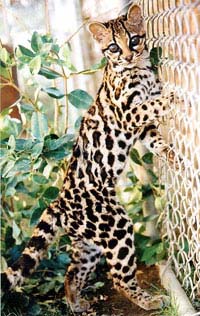
Common Name: Margay
Kingdom: Animalia
Phylum: Chordata (Vertebrata)
Class: Mammalia
Order: Carnivora
Family: Felidae
Genus: Felinae (Leopardus)
Species: wiedii
Misc: Of all of the felines, the Margay is most adapted for a true arboreal life. It is the only cat to possess the ability to rotate its hind legs 180° , enabling it to run head first down trees like squirrels. It can also hang from a branch by one hind foot!
Size and Appearance: This cat is often confused with its near relatives the Ocelot and the Oncilla. Their coats are very similar, and like the others – the Margay’s is a tawny background patterned with black-ringed rosettes and elongated blotches. The fur is thick and plush, and their tail is quite long – averaging 70% of its head and body length. The tail is used as a counterweight to aid in balance. Size wise – the Margay is right in between the Ocelot and the Oncilla weighing between 9-20 pounds and reaching lengths of 34-52 inches. The Margay also has extremely large eyes, which aids in its nighttime vision.
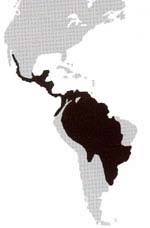 Habitat: The Margay is associated with forest habitat, both deciduous and evergreen. They have occasionally been spotted in shady cocoa or coffee plantations and riverine forests.
Habitat: The Margay is associated with forest habitat, both deciduous and evergreen. They have occasionally been spotted in shady cocoa or coffee plantations and riverine forests.
Distribution: Mexico, the Amazon Basin, Argentina, Uruguay, Belize and Brazil. Extinct in Texas, USA
Reproduction and Offspring: After a gestation of approximately 76-84 days, females produce a litter of 1 kittens. They weigh 2.75-6 ounces at birth and will open their eyes at around 2 weeks old. They are weaned around 2 months of age, and captive females reach sexual maturity around 6-10 months, although they may not reproduce for several months after that.
In captivity, Margays have lived up to 20 years.
Social System and Communication: Unknown.
Hunting and Diet: The primary diet of this cat consists of small arboreal mammals such as big-eared climbing rats, squirrels, opossums, small birds, porcupines, marmosets, capuchins, three-toed sloths, birds and even fruits. Their terrestrial diet consists of various rats and cavies.
Principal Threats: The biggest threat has been the exploitation of its pelt for the fur trade, which reached numbers of 14,000 per year. That number is believed to be greatly underestimated as it was seldom verified which spotted cat the pelts originated from. Sadly, in some areas, illegal hunting for domestic markets or underground fur trade still presents a problem for this little cat. Its greatest threat today, however, is deforestation of its natural habitat. Because of the Margay’s inability to produce large litters (or litters with multiple births!) combined with the fact that they only reproduce once every 2 years and the kitten mortality rate is 50%, their outlook for survival, both in the wild and in captivity, is grim.
Status: CITES: Appendix I. IUCN: Insufficiently known.
Felid TAG recommendation: Margay (Leopardus wiedii). Although popular with zoos and private owners, the margay is more difficult to breed than other small, spotted neotropical felids. The present population in North American zoos is likely nonviable. Given their conservation status and the lack of captive reproduction in range-country zoos, this species is recommended for Phase-Out.
How rare is this cat ? The International Species Information Service lists 64 worldwide, with 26 being in the U.S.
Information reprinted With Permission from the IUCN Wild Cats Book.
See Conservation Work Funded By Big Cat Rescue here:
All conservation insitu work: https://bigcatrescue.org/insitu/



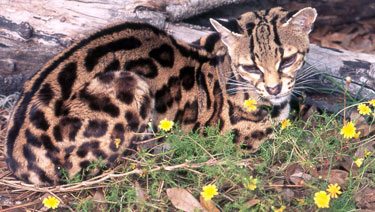
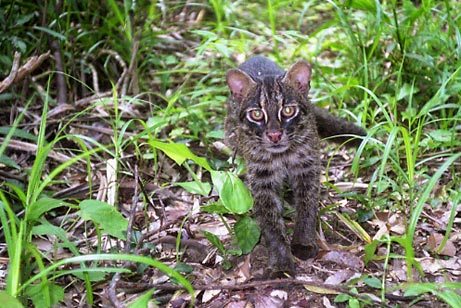
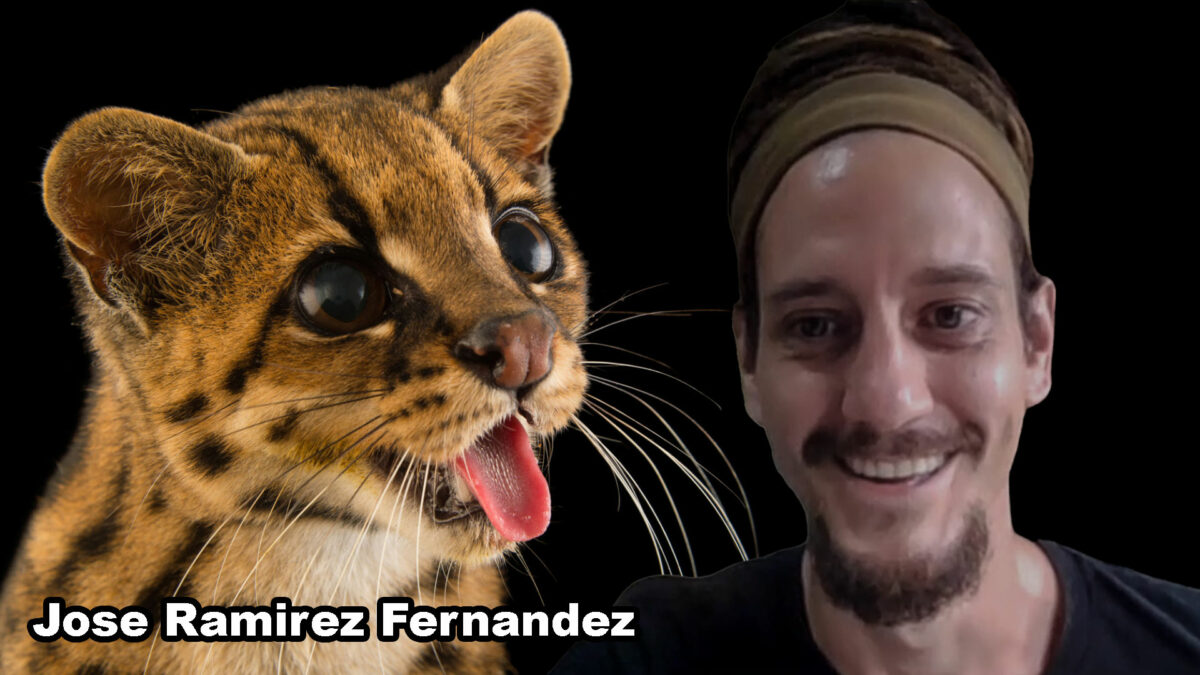
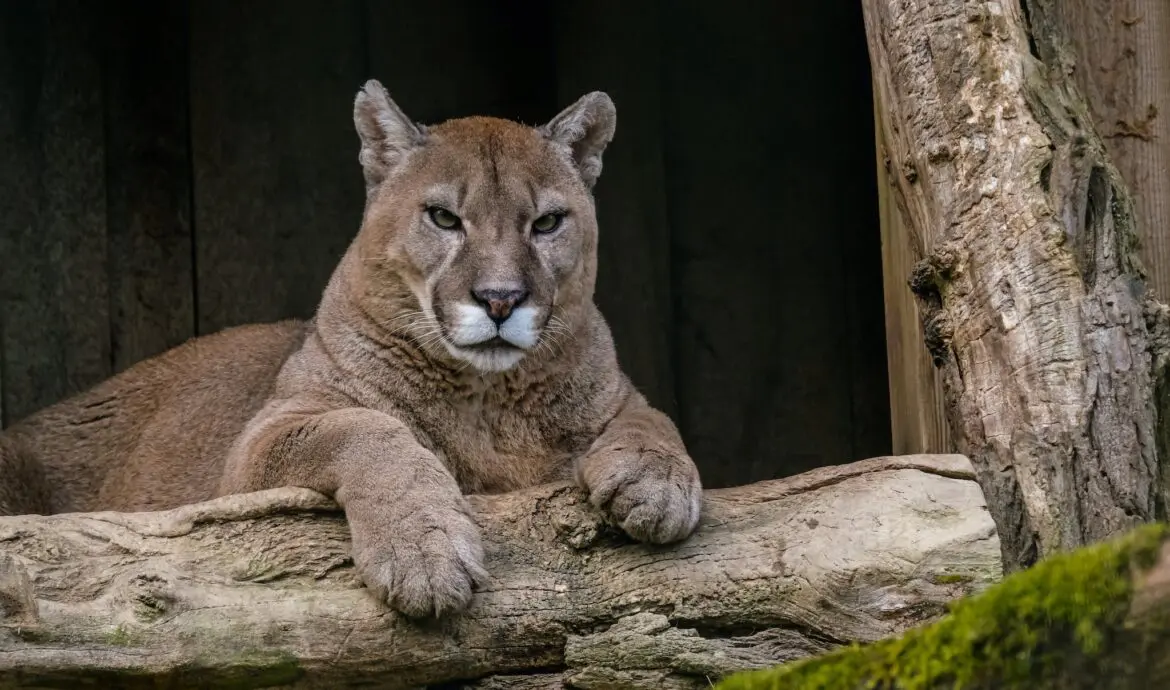

wow
I am also doing this for a project. It’s for nonfiction reading in school.
I am doing this for my project in science do you guys know what are there cells or DNA
If I were to purchase a young Margay legally, what finical burden would I be looking at?
Big cats belong in the wild, not in your home, back yard or basement. They are wild animals. They would never allow you to touch them in the wild. They make horrible pets. They mark (pee) all over everything and scratch to mark their territory. You would better serve the world and nature by leaving them in the wild where they belong and adopting a shelter cat.
Amen
Does the female give birth on the ground also
how many are one earth 2022 though?
They are so beautiful. I love them. They look so soft too.Aliyah
If you can edit this can you add some more info about how they survive???
Does this include baby animals? Would they take young ones if they took the mother?
What does a baby look like?
I would guess very cute?
There talking in the services. 0 in big cat rescue. They hunt them a lot I read around 14000 yearly. And if the number was that low they would be classified diffrently.
I have a question regarding your statement about the margay’s leg being able to rotate 180°. Every other source I’ve read or seen so far states that it is the ankles that rotate, not the leg. Can you confirm which is correct?
Please start a face book page for your research if you can? I would love to follow it!
I've always wanted margays just based on size and a assurance alone. Now that i know there are ONLY 67 of them on the planet in captivity, they're so rare, i HAVE to learn how to and take the necessary steps to keep and breed these beautiful cats.
The are illegal to have as pets
dang that sucks
love em they are beautiful
Kelly, this is Lewis in the wild!